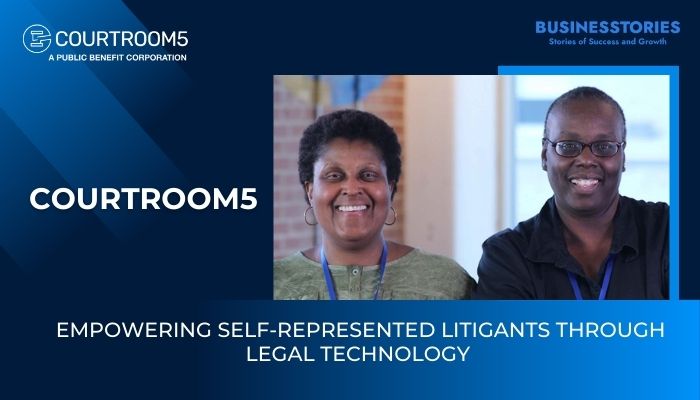Access to justice remains one of the world’s largest unsolved challenges. While the law ideally promises equal rights before courts, the reality is starkly different. For millions of Americans who cannot afford expensive attorneys, the courtroom becomes intimidating, confusing, and outright inaccessible. Each year, millions of people appear in court without a lawyer—known as self-represented litigants or “pro se” litigants—and struggle to navigate complex legal procedures on their own.
In 2017, two women—Sonja Ebron and Debra Slone—faced this challenge personally. Their frustration with the lack of affordable legal help led to the creation of Courtroom5, a groundbreaking legal-tech startup designed to empower individuals to represent themselves effectively in civil court. Merging technology with education, Courtroom5 builds a bridge where the traditional legal system has left a gap—providing self-represented people with tools, coaching, and confidence to stand up for their rights.
This is the startup story of Courtroom5, how two women turned a personal struggle into a national solution, how they navigated obstacles in the justice system, and how their vision is reshaping access to justice in America.
When Experience Meets Necessity
The idea for Courtroom5 was born from real life experience. Sonja Ebron, an electrical engineer and entrepreneur, and Debra Slone, a Ph.D. in library and information science, repeatedly found themselves entangled in legal matters where hiring an attorney was financially unrealistic. Like millions of Americans, they recognized the deep inequity in the legal system, where access to justice often depends on income level.
Both founders experienced that without formal legal representation, they had to take on the challenge of drafting motions, navigating complex courtroom rules, and defending themselves in highly procedural civil cases. The process was overwhelming. Yet through persistence and self-education, they found how to win. Their realization was elegantly simple but powerful, most people who represent themselves in court do not fail because their cases are weak—they fail because they do not know the rules of the legal game.
From this realization emerged a vision, to build a scalable digital platform that equips self-represented litigants with the knowledge, templates, structure, and strategies to handle their cases effectively.
The Birth of Courtroom5
Courtroom5 officially launched as a legal technology platform designed specifically for self-represented litigants in civil cases. Unlike traditional legal-get-help websites that provide only general information, Courtroom5 guides users step by step through their own legal journey.
The company’s platform offers:
- Case management tools to organize documents, track filing deadlines, and manage evidence.
- Context-based tutorials so that litigants understand the procedure relevant to their type of case.
- AI-driven document assembly, helping users draft pleadings, motions, and court filings with confidence.
- Coaching support, giving users human guidance when automation alone is not enough.
- Access to community, where people navigating similar struggles can learn from each other’s experiences.
The design emphasizes not replacing lawyers, but closing the gap for those who cannot afford one. In fact, Courtroom5 positions itself as a vital tool for the growing wave of pro se litigants in civil courts across the United States.
Why Courtroom5 Matters
The U.S. judiciary faces a well-documented “justice gap.” Reports from organizations like the Legal Services Corporation highlight that 86% of civil legal problems faced by low-income Americans receive inadequate or no legal assistance available to address them. Court-appointed lawyers are available in criminal cases, but no such right exists for most civil disputes—cases that involve housing, debt collection, divorce, child custody, and consumer claims.
“Courtroom5 isn’t just a platform—it’s a path to justice for those who’ve been locked out of the system for too long.”
This reality leaves millions of people unrepresented in court. Attorneys are prohibitively expensive, often charging hundreds of dollars per hour. With stakes ranging from losing a home to losing child custody, self-representation can have devastating consequences for those without legal know-how.
Courtroom5 tackles this crisis head-on. By democratizing legal tools, it levels the playing field. Now litigants who would otherwise face trained attorneys alone can access coaching and structured guidance that enhances both their confidence and their chances of winning.
Early Challenges and Breakthroughs
Building Courtroom5 was not easy. The legal industry is historically conservative, slow to adopt new technologies, and heavily regulated. Early critics questioned whether self-represented litigants could be trusted with advanced tools, and whether judges would accept filings prepared without a lawyer’s review.
Ebron and Slone persisted. They leaned on their unique backgrounds—engineering and information science—to architect a system that broke down complex processes into manageable steps. Instead of overwhelming people with legal jargon, Courtroom5 empowers them with clarity.
The breakthrough came when people started reporting real success in their cases. Testimonials revealed that people who once felt powerless were now asserting their rights with confidence. The platform spread especially among debtors facing large financial institutions in court, tenants fighting for housing rights, and individuals those navigating complex divorces.
Recognition and Growth
Courtroom5’s innovative approach quickly caught the attention of the wider startup ecosystem. The company gained national visibility through:
- Legal tech accelerators such as the Duke Law Tech Lab, where Courtroom5 was recognized as a high-potential disruptor.
- Awards in justice innovation from organizations seeking solutions to the access-to-justice gap.
- Media coverage highlighting the role of the startup in transforming access to legal resources for underserved communities.
- Selection in Techstars, one of the world’s most prestigious startup accelerators, providing the company with mentorship, investor connections, and validation in the broader entrepreneurial ecosystem.
This recognition opened doors to partnerships and funding opportunities, setting the stage for broader scale and deeper technology integration.
Unique Value Proposition
Courtroom5 differentiates itself from other legal-resource platforms in several ways:
- End-to-End Support: Rather than handing litigants static legal articles, Courtroom5 provides a workflow solution—from case intake and deadlines to filings and hearings.
- Human + Tech Hybrid: While automation handles much of the grunt work, users have access to coaching and human guidance—ensuring accuracy and confidence.
- Affordable Pricing: Instead of flat legal fees that can reach thousands of dollars, Courtroom5 offers subscription plans that are a fraction of the cost of hiring a full-time attorney.
- Educational Empowerment: The platform does not just give answers—it teaches litigants procedural thinking, enabling them to handle not only a current case but also future interactions with the legal system.
User Stories and Impact
Impact is perhaps the strongest indicator of Courtroom5’s value. Many subscribers report winning cases against creditors, landlords, or estranged spouses—cases they would likely have lost without procedural knowledge. Beyond wins and losses, users describe the platform as providing dignity and agency in a system that often strips people of both.
A tenant in North Carolina, for example, used Courtroom5 to draft strong motions in a housing dispute. A single mother contested an unfair debt claim with confidence after being walked through the proper procedures. The recurring theme is that Courtroom5 restores fairness where resources are otherwise unequal.
Industry Context: Legal Tech and the Justice Movement
Courtroom5 is part of a growing startup in legal tech movement, but its niche sets it apart. Many legal tech startups focus on business model that will enabling law firms to automate tasks and reduce costs. Courtroom5, by contrast, looks directly at the end user — the person without a lawyer.
This approach aligns with broader Access to Justice (A2J) initiatives backed by NGOs, judges, and policymakers. By giving pro se litigants digital capabilities, the startup is directly contributing to national goals of closing the justice gap. In this sense, Courtroom5 is not merely a company but a significant player in the movement for legal system reform.
Future Vision
Looking ahead, Courtroom5 has ambitious plans to expand its reach and capabilities. The team is developing more AI-powered features, capable of analysing case patterns and suggesting litigation strategies with greater accuracy. They also plan to expand their library of tutorials, motion templates, and jurisdiction-specific resources to cover more civil case types across all U.S. states.
Partnerships with courts, nonprofits, and community advocacy groups are also on the horizon. By collaborating directly with the justice system, Courtroom5 hopes to normalize the presence of prepared self-represented litigants, helping courts run more efficiently while delivering more equitable outcomes.
Global expansion is another potential path. While the U.S. represents the most immediate market, self-represented litigants are an international reality. Countries everywhere face the tension between affordability of legal services and the right for fair trials. Courtroom5’s platform could eventually serve a worldwide audience.
The Founders’ Philosophy
Ebron and Slone often emphasize that Courtroom5 is more than a business—it is a mission-driven company born from real experiences. Their leadership reflects the core values of resilience, fairness, and empowerment. Both women bring unique expertise, Ebron’s engineering background fuels the product design and systems architecture, while Slone’s library science expertise ensures access to knowledge and research is at the core of the platform.
Together, they have built not just a company but a voice in the broader conversation about justice and equality. As African-American women entrepreneurs in tech, they also represent the increasing diversity shaping the innovation landscape—a narrative that resonates deeply across startup and social-impact communities.
Next Story: Niramai Health Analytix: Revolutionizing Breast Cancer Detection with AI
Conclusion
Courtroom5’s startup journey illustrates how lived experience can spark innovation in even the most traditional industries. What began as a personal struggle to navigate the civil court system has grown into a technology platform recognized nationally for bridging the justice gap.
By equipping self-represented litigants with tools, knowledge, and confidence to fight in court, Courtroom5 does not just change individual cases—it changes lives. It empowers citizens to stand on equal footing in the courtroom, regardless of income or background.
In a legal world where fairness too often correlates with financial resources, Courtroom5 has emerged as a beacon of innovation, showing that technology can democratize justice. Its future holds not just expansion, but the possibility of reshaping how courts function, making access to justice truly universal.



